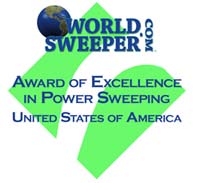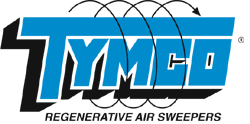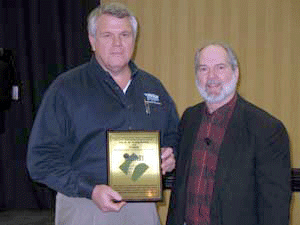Sweeping Excellence Awards |

TYMCO receives 2007 WorldSweeper.com Award of Excellence in Power SweepingIn recognition of TYMCO's tremendous contributions to the power sweeping industry, the B.W. Young family and The Young Manufacturing Company (TYMCO) received WorldSweeper.com's Award of Excellence in Power Sweeping for 2007. B. W. Young and two of his brothers went into the road construction business in the late 40's, right after World War II. They bought surplus military equipment, like motor graders, pavers, dump trucks and tractors. They started out terracing farm land at first. Then, they started building county and city roads, as well as branching out to build curb-and-gutters, building asphalt roads, etc. By the early 60's the Young Brothers Construction Company employed about 200 people. B. W. Young, father of Kenneth and Gary Young, who run TYMCO today, noted that the surface of asphalt would be cracked but the road base would be in good shape. The cracks in the pavement caused roadway failure, especially where water froze in them and ruined the road's base. B. W.'s idea was that if this problem could be fixed, then the roads could be repaired at much less cost than an entire roadway replacement.  This realization led him to invent 'slurry seal,' which is a compound that is in widespread use today. To apply the material, he designed a large, truck-mounted machine designed to apply the slurry to roadways. "I can still remember going to demonstrations of Dad's slurry seal machine when I was in my teens," reminisced Kenneth Young, TYMCO's current president. "In front of the slurry machine would be a pickup truck with an air compressor and an airblast nozzle to get everything out of the pavement cracks. Two or three guys had airhoses and they'd walk ahead and blow all the loose debris out of the cracks. It was very important for the slurry to be able to flow into and completely fill the cracks for the system to work. "At some point, my father decided to make a machine that would be designed specifically for removing the material in the cracks, which was predominantly gravel. That was the beginning of the regenerative air sweeping machine that, for the first time, had a sweeping head that incorporated a blast orifice to blow out those cracks using an 'air knife action.' Then, the machine's suction system deposited the material into a collection hopper. B. W. was also interested in the concept of stormwater runoff, which was just starting to surface in the late '60s. He started noticing all the governmental publications that covered this topic. So, instead of taking the debris-laden air and exhausting it into the atmosphere, he took the air and sent it back through a centrifugal dust separator that he built into the sweeper so it would clean these particles out of the exhaust. "He spent a lot of working on making and refining centrifugal dust separator he could use on a sweeper and elsewhere," continued Kenneth. "For the sweeper, he wanted a system that would really clean the dust particles of the intake air before it was re-pressurized and put back into the regenerative air stream. He designed and built a variety of different types of dust separators that could be used by heavy industry, such as asphalt plants, in order to clean their exhaust. "In 1967, the original patent for the TYMCO regenerative air sweeper system was granted. This included the pickup head blast orifice, and regenerative air looping pickup system. These systems were then incorporated into the first street sweeper bearing the TYMCO name, the model 700. This was a seven cubic yard sweeper body that was mounted onto a Ford cabover truck. It didn't have any sort of dust control or gutter brooms since, for his application of cleaning ahead of the slurry seal machine on flat road surfaces, it didn't need either of those items. "In the late '60s he developed the concept of the gutter broom with a single hydraulic cylinder similar to what we use today. It included hydraulic sequence valves that sensed the load against the ground and would change the hydraulic pressure as needed -- yet would relieve if it hit an immovable object like a fire hydrant or curb. "Another of B. W.'s inventions was a 'truck hook' that enabled an asphalt truck and the paver to keep the correct distance from each other so as to minimize the amount of paving material that would spill. This consisted to a telescoping tubing system that allowed the retracting arm to 'grab' the tailgate of a dump truck and apply enough pressure to hold the dump truck to the asphalt plant. A new type of hydraulic system design allowed the arm to operate correctly at varying distances." Although some of the truck hooks were sold, they were later superseded in the asphalt industry by the Layton Truck Hook, which did the same job via grabbing the wheels of the truck. Upgrades of this latter system are still in widespread use today. However, B. W. Young's pressure-relieving system that was a central component of the truck hook was adapted to build the hydraulic system design that today allows gutter brooms to relieve, instead of becoming damaged, when they come up against a solid object. The sweepers were first developed starting in about 1965, and sold starting about 1967. From 1968, they were sold under the TYMCO name, which stood for the Young Manufacturing Company (a division of the Young Brothers Construction Co.) so as to keep that part of the business separate from the construction aspects. It was not until March of 1973, however, when B. W. and his brothers bought each other out. The three Young brothers split up to form three separate companies. One retained the family construction business, the second formed Slurry Seal International, and Mr. B.W. Young incorporated and federally registered TYMCO - The Young Manufacturing COmpany. Unfortunately, just three months later he passed away, in June 1973, at the early age of 52. This unfortunate happenstance vaulted his wife, Sophie, into presidency of the company. By that time, the firm had 60 to 70 employees. At the time of his father's death Kenneth, the oldest son, was just 21. "Although I had worked at the company for about a year, as well as gone in and out of college," said Kenneth, "mostly I was interested in pursuing my dream of playing professional football. That's another story for another time. My younger brother, Gary, was 18 and just starting his first year of college. I came back and worked at the company while Gary completed his degree in mechanical engineering at Texas A&M before coming back to work full time at the plant in 1977." In the early years of market development, TYMCO sweepers were sold by salesmen who simply traveled around the country demonstrating them on city streets and on large parking lots for curious contractors and public officials looking for a sweeper with better performance and less downtime. When the need for a smaller sweeper became evident, Mr. Young developed the "parking lot size" TYMCO Model 300. In the first two years of its introduction, it became the most accepted parking lot sweeper on the market. Later, the Model 210 was developed, which was the first TYMCO to feature a hydraulically-operated high dump with a 60-inch reach. This allowed it to (you can imagine the excitement of the sweeping contractor community) dump into garbage dumpsters, reducing dump time and increasing productivity. Today the TYMCO Model 210 is the company's most popular parking lot sweeper. Under the leadership of Kenneth and Gary Young, the company has expanded to become one of the leading sweeper companies in the world. In 2007, TYMCO employs over 150 people, with its manufacturing facility still located in Waco, Texas, where it started. TYMCO sweepers are now sold in over 25 different countries around the world, and the firm's distribution network is a professional organization that includes approximately 60 locations in the U.S. The company also boasts half a dozen active distributors overseas. They have a leading airport runway sweeper, and also were a pioneer of the dustless technology that has become so important under the USEPA Clean Air Act and Clean Water Act. The dustless features available on the 600, especially when paired with CNG operation (TYMCO pioneered CNG-powered sweepers), position the 600 as perhaps the leading small-micron pickup sweeper on the market today for combating stormwater runoff pollution. Of more import to this Award, the management philosophy is one that truly values its employees and its corporate integrity. Even more central to the company being chosen as recipient of the WorldSweeper.com Award of Excellence in Sweeping for 2007 is the corporate citizenship that is so central to the TYMCO name and legacy. The company is one of the dying breed of family-run firms that offer a high degree of employee loyalty, with many members having worked there for two decades or more. 
Additionally, throughout the years TYMCO managers have continually maintained a very positive, high profile leadership role in the power sweeping industry as a whole. TYMCO management has been a central force in developing and helping to nurture and maintain the various sweeping contractor associations that have been central to helping elevate the professional status of the power sweeping industry. This includes the one now known as the North American Power Sweeping Association, There could be no more fitting recipient of WorldSweeper.com's 2007 Award of Excellence in Power Sweeping than The Young Manufacturing Company. " Our editor, Ranger Kidwell-Ross, presented Kenneth Young, president of TYMCO, with a commemorative plaque on February 1, 2007 at the National Pavement Exposition in Nashville, Tennessee. |
© 2005 - 2021 World Sweeper
|
Back to Sweeping Excellence Table of ContentsSite Map / Table of Contents |